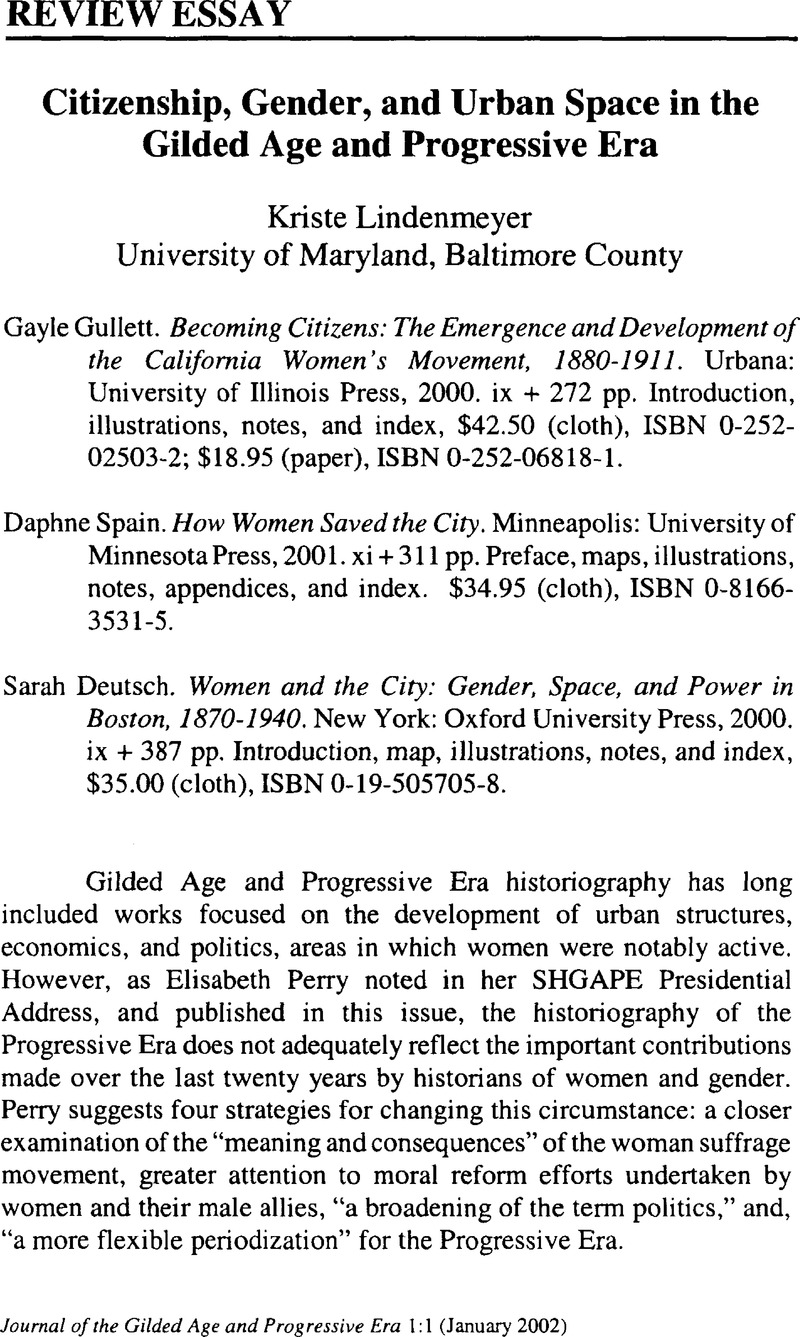Article contents
Citizenship, Gender, and Urban Space in the Gilded Age and Progressive Era
Review products
Published online by Cambridge University Press: 08 November 2010
Abstract

Information
- Type
- Review Essay
- Information
- The Journal of the Gilded Age and Progressive Era , Volume 1 , Issue 1 , January 2002 , pp. 95 - 106
- Copyright
- Copyright © Society for Historians of the Gilded Age and Progressive Era 2002
References
1 SHGAPE sponsored a panel honoring Robert Wiebe for his seminal book, The Search for Order, 1877–1920 (New York, 1967) during the 1997 AHA Annual Meeting held in New York City, (January 3, 1997). The papers presented during this panel by Ixon Fink, Martin Sklar, and Robyn Muncy are published on the H-SHGAPE website located at http://www2.h-net.msu.edu/-shgape/wiebe/index.html Muncy's paper praises Wiebe's work, but also highlights its limited attention to female progressives; Robyn Muncy, “The Search for Order Reconsidered,” paper presented at the 1997 AHA meeting, January 3, 1997, http://www2.h-net.msu.edu/-shgape/wiebe/muncy.html
2 Freeman, Jo, One Room at a Time: How Women Entered Politics (Lanham, MD, 2000), x.Google Scholar
3 DuBois, Ellen Carol, Feminism and Suffrage: The Emergence of an Independent Woman's Movement in America, 1848–1869 (Ithaca, NY, 1978).Google Scholar
4 Nugent, Walter, Into the West: The Story of Its People (New York, 1999), 124–25, 222–24.Google Scholar
5 Ray Suarez interview with Spain, Daphne, “Newshour with Jim Lehrer,” Public Broadcasting Corporation, September 10, 2001,Google Scholar available on the PBS website at http://www.pbs.org/newshour/conversation/july-dec01/women_9–10.html
6 On the growing role of female professionals in social welfare work see, for example, Lindenmeyer, Kriste, “A Right to Childhood”: The U.S. Children's Bureau and Child Welfare, 1912–1946 (Urbana, 1997)Google Scholar; Michel, Sonya, Children's Interests/Mothers' Rights: The Shaping of America's Child Care Policy (New Haven, 1999)Google Scholar; and Muncy, Robyn, Creating a Female Dominion in American Reform, 1890–1920 (New York, 1991).Google Scholar
7 Hayden, Dolores, The Grand Domestic Revolution: A History of Feminist Designs for American Homes, Neighborhoods, and Cities (Cambridge, MA, 1981)Google Scholar and The Power of Place: Urban Landscapes as Public History (Cambridge, MA, 1995).
8 For examples on women and the state see, Baker, Paula, “The Domestication of Politics: Women and American Political Society, 1780–1920”, American Historical Review 88 (June 1984): 620–47CrossRefGoogle Scholar; Boris, Eileen, “The Power of Motherhood: Black and White Activist Women Redefine the ‘Political,’” Yale Journal of Law and Feminism 2 (1989): 25–49Google Scholar; Goodwin, Joanne L., Gender and the Politics of Welfare Reform: Mothers' Pensions in Chicago, 1911–1929 (Chicago, 1997).CrossRefGoogle Scholar
- 1
- Cited by

